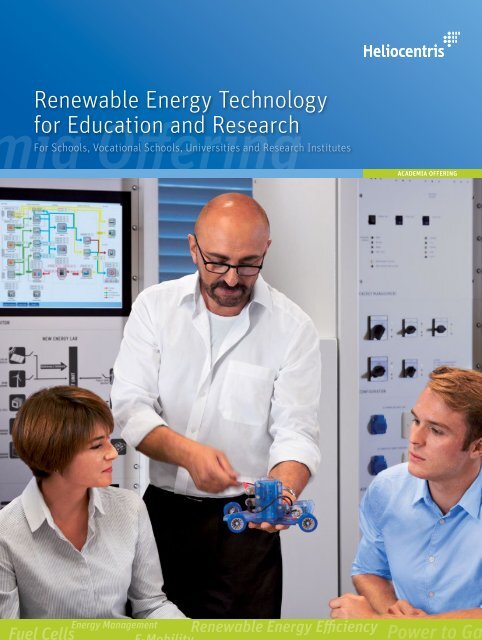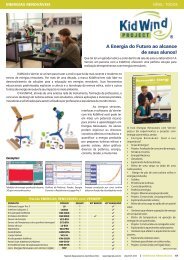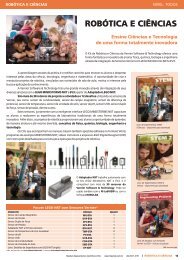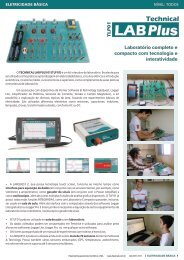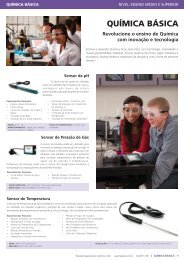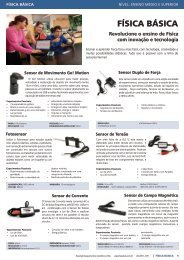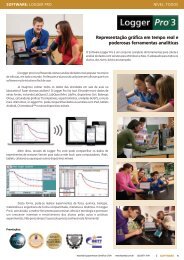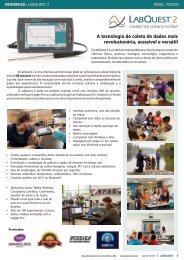Heliocentris - Energias Renováveis
Create successful ePaper yourself
Turn your PDF publications into a flip-book with our unique Google optimized e-Paper software.
Renewable Energy Technology<br />
for Education and Research<br />
For Schools, Vocational Schools, Universities and Research Institutes<br />
ia Offering<br />
ACADEMIA OFFERING<br />
Energy Management<br />
Fuel Cells<br />
Renewable Energy Efficiency<br />
Power to Ga
<strong>Heliocentris</strong> Academia – Your Partner for Instruction<br />
in Renewable Energies, Energy Storage and Energy Management.<br />
ACADEMIA OfferING<br />
Knowledge about renewable energies and their storage<br />
have become a permanent fixture in our lives and will play<br />
an even greater role in the future.<br />
The education of students in this technology is a central element<br />
of our mission.<br />
<strong>Heliocentris</strong> training products help students at schools, universities and research<br />
institutions to understand key concepts regarding renewable energy,<br />
energy management and energy storage. You will bring students closer to these<br />
complex technologies, while achieving the desired learning outcomes in a fun and<br />
interesting way. <strong>Heliocentris</strong> products will pique the interest of students and assist<br />
instructors in the key areas of Science, Technology, Engineering and Mathematics.<br />
Each product includes well written manuals, instructional material and software that is<br />
tailored to the key topics covered by the system. While the curriculum topics vary, they<br />
help give students the required knowledge to understand renewable energy systems.<br />
Our products stand for:<br />
»»<br />
Curricular relevance and didactic quality<br />
»»<br />
Measurement precision and excellent workmanship<br />
»»<br />
High quality products and robust construction<br />
»»<br />
Simple and fast commissioning and operation<br />
»»<br />
Versatile areas of application in chemistry, physics and electrical engineering<br />
»»<br />
Target-group-specific documentation and experiments for students<br />
2<br />
Preface
<strong>Heliocentris</strong> Academia<br />
Training Products for Schools, Universities and Research Institutes<br />
School Level<br />
Model Car Page 04<br />
04<br />
Science Kit Page 05<br />
Professional Page 06<br />
Class Sets and Instruction Material Page 07<br />
Higher Education<br />
Clean Energy Trainer Page 08<br />
Clean Energy Trainer Laboratory Set Page 09<br />
Fuel Cell Trainer Page 10<br />
Fuel Cell Integration System Page 11<br />
Nexa® Training System Page 12<br />
Nexa® Integration System Page 13<br />
06<br />
08<br />
Renewable Energy Laboratory Solutions<br />
Solar Hydrogen Extension Page 14<br />
New Energy Lab Page 15<br />
Water-Cooled Fuel Cell Systems<br />
12<br />
10<br />
FC-42 Evaluation Kit Page 16<br />
HyPM High Power Fuel Cell Lab Page 16<br />
Accessories<br />
13<br />
Hydrogen Supply & Solar-Hydrogen Add-on Page 17<br />
Bundled Laboratory Solutions Page 18<br />
18<br />
14<br />
15<br />
Table of Contents<br />
3
Teacher's Guide<br />
www.heliocentris.com<br />
.<br />
Demonstrating the Dr FuelCell® Model Car<br />
2. Fill the reversible fuel cell with distilled water, see PREPARATION<br />
on page 19.<br />
3. Instead of step 7 in the preparation, turn the fuel cell right side<br />
up.<br />
TIP<br />
For this investigation it is recommended to use the solar panel as a<br />
source for electrical energy. Or you may also use the hand generator<br />
instead (see Instruction Manual).<br />
NOTICE<br />
Overheating of the solar panel!<br />
Malfunctioning of or permanent damage to the solar cells.<br />
Only use light sources with a maximum power of 120 W.<br />
Keep a minimum distance of 20 cm (8 inches) between light<br />
source and solar panel.<br />
Do not concentrate light.<br />
4. Set up the solar panel and lamp.<br />
Fig. 4-2 Using the reversible fuel cell as an electrolyzer<br />
Producing 5. Plug the red banana jacks (1, 3) of the red patch cord into the<br />
hydrogen red (positive) banana jack terminals of the solar panel (1) and the<br />
fuel cell (3).<br />
6. Repeat step 5 with the black patch cord (2, 4) and the negative<br />
terminals.<br />
7. Turn on the light.<br />
Teacher's Guide – Dr FuelCell ® Model Car 21<br />
Model Car<br />
Model Car<br />
06.13/JT | Printed in Germany<br />
Model Car<br />
ACADEMIA OFFERING<br />
School Level<br />
Model Car<br />
Model Car with Reversible Fuel Cell<br />
Includes<br />
Instructional<br />
Materials<br />
Powered by water and sunlight, the Model Car is a vivid<br />
introduction to the topic of renewable energies. With<br />
pre-configured experiments and a curriculum-oriented<br />
instruction manual, the contents of solar, hydrogen and<br />
fuel cell technology can be easily communicated.<br />
The Model Car is distinguished by its flexible and durable construction<br />
and can be used for individual or group work. The numerous<br />
experiments can be practically implemented for current topics such<br />
as energy storage and alternative drives.<br />
Key Features<br />
»»<br />
Design of fuel cells and solar cells<br />
»»<br />
How to measure the current and the voltage of the fuel cell<br />
»»<br />
Up to 5 students can work with the Model Car at the same time<br />
Components<br />
»»<br />
Suitable for communicating subject matter from physics,<br />
chemistry and technology curricula<br />
»»<br />
CO 2<br />
-free mobility<br />
»»<br />
Energy Storage and use of renewable energies<br />
»»<br />
Chemical reactions of the entire energy conversion chain<br />
Reversible fuel cell<br />
Solar panel<br />
Chassis<br />
(e.g. water to hydrogen and oxygen)<br />
A tention: Use and replication of the image data is only permitted with written approval by LECHUZA, write to pr@lechuza.com |<br />
Storage box<br />
Hand generator*<br />
Load measurement<br />
box*<br />
Ring binder and CD<br />
Sample Experiments<br />
»»<br />
Energy conversion<br />
»»<br />
How to measure the current and the voltage<br />
of the fuel cell and electrolysis<br />
»»<br />
Hydrogen generation by means of electrolysis via solar<br />
module or hand generator<br />
»»<br />
Load measurement box for measuring current and voltage<br />
»»<br />
Characteristic curves of current and voltage<br />
»»<br />
Measurement of electrical charge<br />
»»<br />
Various load settings possible for measuring the effect<br />
on current and voltage<br />
»»<br />
Use of renewable energies<br />
»»<br />
Design of fuel cells<br />
»»<br />
Design of solar cells<br />
»»<br />
Solar cell: measurement of electrical power depending on<br />
the alignment of the solar module and the intensity of the<br />
light source (measurement curves)<br />
»»<br />
Generation of electrical energy<br />
Dr FuelCell ® Model Car<br />
Product Options<br />
Model Car Complete<br />
The measurement box enables quantitative<br />
investigations. Power can be<br />
generated with the hand generator as<br />
an alternative to the solar module<br />
»»<br />
Reversible fuel cell<br />
»»<br />
Solar panel<br />
»»<br />
Chassis<br />
»»<br />
Instruction material with experiment<br />
Guide in ring binder + CD<br />
»»<br />
Bottle with distilled water<br />
»»<br />
Cable set<br />
»»<br />
Load measurement box*<br />
»»<br />
Hand generator*<br />
Accessories<br />
Model Car Demo<br />
Numerous simple demonstration experiments<br />
for physics, chemistry and technology lessons<br />
»»<br />
Reversible fuel cell<br />
»»<br />
Solar panel<br />
»»<br />
Chassis<br />
»»<br />
Instruction material with Experiment Guide<br />
in ring binder + CD<br />
»»<br />
Bottle with distilled water<br />
»»<br />
Cable set<br />
Model Car<br />
available as<br />
a class set.<br />
Page 7<br />
Art. no. 354 Art. no. 352<br />
Lamp Double spotlight for simulating sunlight Art. no. 314<br />
Dimensions (W x H x D): 345 x 160 x 280 mm, weight: approx. 2.9 kg.<br />
*Only included with Model Car Complete.<br />
4 Model Car
Kennlinie der Brennstoffzelle<br />
Material:<br />
Zerlegbare Brennstoffzelle mit Membran Verbraucher-Messbox<br />
0,3 mg/cm 2 Pt sowie Wasserstoff- und 4 Kabel<br />
Sauerstoffendplatte montiert nach<br />
2 lange Schläuche<br />
Aufbauanleitung<br />
2 kurze Schläuche<br />
2 Schlauchverschlussstopfen<br />
Komponenten aus Schülerkasten<br />
Solar-Wasserstoff-Technologie:<br />
Zusätzliche Komponenten:<br />
Solarmodul<br />
Lampe 100-150 Watt<br />
Elektrolyseur<br />
Destilliertes Wasser<br />
Durchführung:<br />
Beachten Sie die Anweisungen aus der Bedienungsanleitung!<br />
Beim Experimentieren Schutzbrille tragen und Zündquellen fernhalten!!!<br />
Bild z1a (Spülen):<br />
Verbraucher-Messbox<br />
Solarmodul<br />
A V R<br />
Lampe<br />
+ + - -<br />
+ -<br />
+ -<br />
0 ml ml 0<br />
2<br />
2<br />
4<br />
4<br />
6<br />
6<br />
8<br />
8<br />
O 2 H<br />
10<br />
10<br />
2<br />
O2 H2<br />
Elektrolyseur<br />
Brennstoffzelle<br />
© Copyright 2002 heliocentris<br />
Interpretation/Hinweise:<br />
1<br />
0,9<br />
0,8<br />
0,7<br />
0,6<br />
0,5<br />
0,4<br />
0,3<br />
0,2<br />
0,1<br />
0<br />
300<br />
250<br />
200<br />
150<br />
100<br />
50<br />
Kenlinie als Funktion der Katalysatorbelegung<br />
Katalysator 0,1 mg<br />
Katalysator 0,3 mg<br />
0 100 200 300 400 500<br />
Strom in mA<br />
Leistung als Funktion der Katalysatorbelegung<br />
Katalysator 0,1 mg<br />
Katalysator 0,3 mg<br />
0<br />
0 100 200 300 400 500<br />
Strom in mA<br />
Die Interpretation der Ergebnisse ist zusammenfassend in Anleitung z6 beschrieben.<br />
© Copyright 2002 heliocentris<br />
FARADAY- und Energiewirkungsgrad<br />
der<br />
Brennstoffzelle<br />
Material:<br />
Zerlegbare Brennstoffzelle mit Membran Verbraucher-Messbox<br />
0,3 mg/cm 2 Pt sowie Wasserstoff- und Stoppuhr<br />
Sauerstoffendplatte montiert nach<br />
4 Kabel<br />
Aufbauanleitung<br />
2 lange Schläuche<br />
2 kurze Schläuche<br />
Komponenten aus Schülerkasten<br />
2 Schlauchverschlussstopfen<br />
Solar-Wasserstoff-Technologie:<br />
Solarmodul<br />
Zusätzliche Komponenten:<br />
Elektrolyseur<br />
Lampe 100-150 Watt<br />
Destilliertes Wasser<br />
Durchführung:<br />
Beachten Sie die Anweisungen aus der Bedienungsanleitung!<br />
Beim Experimentieren Schutzbrille tragen und Zündquellen fernhalten!!!<br />
Bild z2a (Spülen):<br />
Verbraucher-Messbox<br />
Solarmodul<br />
A V R<br />
Science Kit<br />
Lampe<br />
Science Kit<br />
+ + - -<br />
ACADEMIA OFFERING<br />
+ -<br />
+ -<br />
0 ml ml 0<br />
2<br />
2<br />
4<br />
4<br />
6<br />
6<br />
8<br />
8<br />
O 2 H<br />
10<br />
10<br />
2<br />
Science Kit<br />
O2 H2<br />
Elektrolyseur<br />
Brennstoffzelle<br />
© Copyright 2002 heliocentris<br />
06.13/JT | Printed in Germany<br />
Science Kit<br />
Practice and Demonstration Set for Solar Hydrogen Technology<br />
The Science Kit is an extensive experiment set for the<br />
subject of renewable energies. 20 pre-configured<br />
experiments and accompanying materials make it a<br />
complete solution for physics and chemistry lessons.<br />
Includes<br />
Instructional<br />
Materials<br />
School Level<br />
The components form a complete solar-hydrogen energy conversion<br />
chain and can be flexibly combined with one another. The topic of<br />
renewable energies can be approached in consideration of the entire<br />
conversion chain or on the level of the individual technologies, such<br />
as photovoltaics or fuel cells. All components can be used and investigated<br />
separately.<br />
Key Features<br />
»»<br />
Basic design of fuel cells and solar cells<br />
»»<br />
Up to 5 students can work with the Science Kit at the same time<br />
»»<br />
Suitable for communicating subject matter from physics, chemistry<br />
Components<br />
and technology curricula<br />
»»<br />
Energy Storage and use of renewable energies<br />
»»<br />
Chemical reactions of the entire energy conversion chain, e.g. water<br />
to hydrogen and oxygen or methanol to carbon dioxide and current<br />
»»<br />
Hydrogen generation by means of electrolysis via solar module or<br />
hand generator<br />
»»<br />
Conversion of solar energy to electronic energy and hydrogen<br />
»»<br />
Calculating the efficiency of fuel cells<br />
»»<br />
Use of stored energy<br />
»»<br />
Separation of water into hydrogen and oxygen<br />
Fuel cell<br />
Load measurement<br />
box<br />
Methanol fuel cell*<br />
E z2<br />
A tention: Use and replication of the image data is only permitted with written approval by LECHUZA, write to pr@lechuza.com |<br />
Storage box<br />
FUEL CELL COMPONENTS*<br />
Instruction material with Experiment Guide<br />
and CD<br />
Sample Experiments<br />
»»<br />
Examination of solar cells and their efficiency<br />
»»<br />
How to determine the tilt angle of solar cells<br />
»»<br />
How many solar cells supply a house?<br />
»»<br />
Investigation of water electrolysis –<br />
how is water separated?<br />
»»<br />
Investigation of the electrolyzer: Does current increase<br />
when the voltage is increased?<br />
»»<br />
Examination of a hydrogen and methanol fuel cell<br />
»»<br />
How does the green house effect work?<br />
»»<br />
Examination of efficiency in the system<br />
»»<br />
Investigating electrolyzers and fuel cells<br />
»»<br />
Hydrogen as an energy carrier and storage<br />
»»<br />
How to create a characteristic curve of an electrolyzer<br />
and of a hydrogen and methanol fuel cell<br />
»»<br />
Calculating the Faraday efficiency of an electrolyzer<br />
E z1<br />
Spannung in V<br />
Leistung in mW<br />
Product Options<br />
Science Kit Complete<br />
Basic experiments and in-depth<br />
experiments for various fuel cell types<br />
»»<br />
Electrolyzer<br />
»»<br />
Fuel cell<br />
»»<br />
Solar panel<br />
»»<br />
Load measurement box<br />
»»<br />
Instruction material with Experiment<br />
Guide + CD<br />
»»<br />
Take-apart fuel cell*<br />
»»<br />
Methanol fuel cell*<br />
Accessories<br />
Science Kit Demo<br />
A variety of basic experiments for<br />
physics, chemistry or technology<br />
lessons<br />
»»<br />
Electrolyzer<br />
»»<br />
Fuel cell<br />
»»<br />
Solar panel<br />
»»<br />
Load measurement box<br />
»»<br />
Instruction material with Experiment Guide + CD<br />
Art. no. 355 Art. no. 350<br />
Lamp Double spotlight for simulating sunlight Art. no. 314<br />
Dimensions (W x H x D): 430 x 150 x 310 mm, weight: approx. 5.6 kg.<br />
*Only included with Science Kit Complete.<br />
Science Kit<br />
is available as<br />
a class set.<br />
Page 7<br />
Science Kit<br />
5
Experimentvariationen:<br />
Sie können den Einfluss der Lichtintensität auf die Leistung des<br />
Solarmoduls bestimmen. Nehmen Sie hierzu zwei weitere Kennlinien bei<br />
verändertem Abstand der Lampe auf (z.B. 20 cm und 40 cm).<br />
Bei einem Abstand von 20 cm darf das Solarmodul nur für die<br />
Dauer der Messung beleuchtet werden!<br />
Tragen Sie P über U auf und vergleichen Sie mit dem P-U-Diagramm bei<br />
einem Lampenabstand von 30 cm.<br />
2000<br />
Abstand 20 cm<br />
Abstand 30 cm<br />
1500<br />
Abstand 40 cm<br />
1000<br />
500<br />
0<br />
0 0,5 1 1,5 2 2,5<br />
Spannung / V<br />
© Copyright 2000 heliocentris -8- Experiment s1<br />
Teil 2: Hellkennlinie<br />
Bild s1b<br />
Messgerät<br />
+<br />
V<br />
-<br />
-<br />
Verbrauchermodul<br />
M<br />
Solarmodul<br />
Lampe<br />
1. Bauen Sie eine Anordnung nach Bild s1b auf.<br />
2. Leuchten Sie das Solarmodul mit einer Lampe gut aus (Abstand Lampe-Solarmodul etwa 30 cm,<br />
der Strom sollte im Kurzschluss etwa 700 mA betragen).<br />
3. Warten Sie ca. 5 Minuten bis sich das Modul erwärmt hat und die Kennlinie bei einer relativ<br />
gleichmäßigen Temperatur aufgenommen werden kann.<br />
4. Beginnen Sie mit der Messung des Kurzschlussstromes (überbrückte Widerstände) und messen<br />
Sie dann die Werte für Spannung und Stromstärke bei unterschiedlichen Widerständen (0,3, 0,5,<br />
1, 2, 3, 5, 10, 20, 50, 100 Ω). Der letzte Messwert ist der in Schalterstellung "OFFEN".<br />
© Copyright 2000 heliocentris -4- Experiment s1<br />
R<br />
06.13/JT | Printed in Germany<br />
ACADEMIA OFFERING<br />
School Level<br />
Professional<br />
Practice and Demonstation Unit<br />
for Solar Hydrogen Technology<br />
The Professional Training System forms a complete solar-<br />
hydrogen energy circuit. Electric current is generated by<br />
a solar cell, stored by means of electrolysis and converted<br />
back in a fuel cell which supplies a consumer.<br />
The Professional Training System supports you in presentations to<br />
the class. Solar technology and fuel cells can be investigated in detail.<br />
Large components and easy-to-read displays are ideal for group<br />
presentations.<br />
Pre-configured experiments and comprehensive documentation simplify<br />
lesson preparation.<br />
Key Features<br />
»»<br />
Demonstration unit for classroom-style teaching<br />
»»<br />
Suitable for communicating subject matter from physics,<br />
chemistry and technology curricula<br />
»»<br />
Basic design of fuel cells and solar cells<br />
»»<br />
How to measure the current and the voltage of the fuel cell and electrolyzer<br />
»»<br />
Energy storage and use of renewable energies<br />
»»<br />
Chemical reactions of the entire energy conversion chain<br />
»»<br />
Water to hydrogen and oxygen<br />
»»<br />
Hydrogen generation by means of electrolysis via solar module<br />
or hand generator<br />
»»<br />
Quick guide for fast commissioning<br />
»»<br />
Complete energy conversion chain from solar energy to hydrogen<br />
and into electrical energy again<br />
»»<br />
Observing increased efficiency of fuel cells<br />
Includes<br />
Instructional<br />
Materials<br />
A tention: Use and replication of the image data is only permitted with written approval by LECHUZA, write to pr@lechuza.com |<br />
Professional<br />
Professional<br />
Professional<br />
f<br />
Instruction material with<br />
Experiment Guide + CD<br />
Solar panel<br />
MEASURING UNIT 1<br />
DOUBLE FUEL CELL<br />
Load<br />
ELECTROLYZER<br />
LAMP<br />
Sample Experiments<br />
»»<br />
Examination of solar cells and their efficiency<br />
»»<br />
How to determine the tilt angle of solar cells<br />
»»<br />
How many solar cells supply a house?<br />
»»<br />
Investigation of water electrolysis:<br />
How is water separated?<br />
»»<br />
Investigation of the electrolyzer – does current increase<br />
when the voltage is increased?<br />
»»<br />
Examination of a hydrogen and a methanol fuel cell<br />
»»<br />
How does the green house effect work?<br />
»»<br />
Examination of efficiency in the system<br />
»»<br />
Investigating electrolyzers and fuel cells<br />
»»<br />
Hydrogen as an energy carrier and storage<br />
»»<br />
Characteristic curve of an electrolyzer and<br />
a hydrogen fuel cell<br />
»»<br />
Calculating the Faraday efficiency of an electrolyzer<br />
Leistung / mW<br />
+ A<br />
Product Options<br />
Professional Complete<br />
Visualization of measurement data<br />
by the measuring unit<br />
Professional Demo<br />
Numerous descriptive demonstration<br />
experiments for physics, chemistry and<br />
technology lessons<br />
»»<br />
Solar panel<br />
»»<br />
Solar panel<br />
»»<br />
Electrolyzer<br />
»»<br />
Electrolyzer<br />
»»<br />
Double fuel cell<br />
»»<br />
Double fuel cell<br />
»»<br />
Load<br />
»»<br />
Load<br />
»»<br />
Instruction material with<br />
»»<br />
Instruction material with<br />
Experiment Guide + CD<br />
Experiment Guide + CD<br />
»»<br />
Lamp<br />
»»<br />
Lamp<br />
»»<br />
Measuring unit 1<br />
Dimensions (W x H x D): 600 x 840 x 460 mm, weight: approx. 10.1 kg.<br />
1<br />
Measuring unit only included with Professional Complete.<br />
Art. no. 392 Art. no. 391<br />
6<br />
Professional
06.13/JT | Printed in Germany<br />
ACADEMIA OFFERING<br />
Science Kit<br />
Science Kit<br />
ACADEMIA OFFERING<br />
Science Kit<br />
06.13/JT | Printed in Germany<br />
06.13/JT | Printed in Germany<br />
ACADEMIA OFFERING<br />
Science Kit<br />
Science Kit<br />
ACADEMIA OFFERING<br />
Science Kit<br />
06.13/JT | Printed in Germany<br />
Class Sets and Instruction Material<br />
The affordable offer for the entire class.<br />
The class sets are designed for use by six groups<br />
of four students each.<br />
One set of Instructional Material is included in each set.<br />
School Level<br />
Professional Complete – class set<br />
Professional Demo – class set<br />
+ +<br />
A tention: Use and replication of the image data is only permitted with written approval by LECHUZA, write to pr@lechuza.com |<br />
+ +<br />
A tention: Use and replication of the image data is only permitted with written approval by LECHUZA, write to pr@lechuza.com |<br />
1 x Professional Complete<br />
6 x Science Kit Basic*<br />
1 x Science Kit<br />
instructional<br />
materials<br />
1 x CD<br />
1 x Professional Demo<br />
6 x Science Kit Basic*<br />
1 x Science Kit<br />
instructional materials<br />
1 x CD-ROM<br />
Includes the Professional Complete for presentations to the class.<br />
It is based on the same didactic concept as the included Science Kits.<br />
Includes the Professional Demo (without measuring module) for presentations<br />
to the class. It is based on the same didactic concept as the included<br />
Science Kits.<br />
Art. no. 927<br />
Art. no. 915<br />
Science Kit Basic – class set<br />
Model Car Complete – class set<br />
Model Car<br />
Class Set<br />
+ +<br />
A tention: Use and replication of the image data is only permitted with written approval by LECHUZA, write to pr@lechuza.com |<br />
Science Kit<br />
Science Kit<br />
Science Kit<br />
A tention: Use and replication of the image data is only permitted with written approval by LECHUZA, write to pr@lechuza.com |<br />
Model Car<br />
Model Car<br />
Model Car<br />
6 x Science Kit Basic*<br />
1 x Science Kit instructional materials<br />
1 x CD 6 x Model Car Complete*<br />
1 x Model Car instructional materials<br />
1 x CD<br />
Includes the Science Kit Basic for experiments together with the class.<br />
Includes the Model Car Complete for experiments together with the class.<br />
Art. no. 916<br />
Art. no. 926<br />
*Without instruction material.<br />
CLASS SETS<br />
7
Clean Energy Trainer<br />
Experiment Guide<br />
Learning the different features of a wind generator<br />
Experiment 1<br />
How do current and voltage behave with a varying rotor<br />
blade position?<br />
1. Set up experiment as shown in Fig.3-1.<br />
2. Affix all rotor blades on the wind generator. In doing so, affix the<br />
rotor blades so that they are unbent.<br />
3. Switch on the fan.<br />
The fan must be set up directly facing the wind generator with<br />
distance of approx. 50 cm.<br />
4. Start the software and select the WIND GENERATOR tab. Switch the<br />
operation mode to MANUAL MODE.<br />
5. Change the position of all rotor blades evenly by rotating.<br />
6. Make note of any observations.<br />
7. Find the rotor blade position with which the wind generator<br />
provides the highest no-load voltage.<br />
How do current and voltage behave with fewer rotor<br />
blades?<br />
1. Set up experiment as shown in Fig.3-1.<br />
2. Optimally position the fan.<br />
3. Start the software and select the WIND GENERATOR tab.<br />
Fig.3-1<br />
4. Switch the operation mode to MANUAL MODE.<br />
5. Remove the rotor blades successively. Make sure that they are<br />
aligned symmetrically.<br />
6. Enter any observations in the following table.<br />
Number of rotor blades<br />
6 5 4 3 2 1<br />
U [V]<br />
How do the measurements behave with varying wind<br />
direction?<br />
1. Align the rotor blades optimally.<br />
2. Turn the wind generator and observe the measurements.<br />
How do the measurements behave if the air flow is<br />
disrupted?<br />
1. Turn on the wind generator and fan.<br />
2. Hold various objects between the fan and wind generator and<br />
observe the measurements.<br />
Clean Energy Trainer - Experiment Guide 27<br />
Clean Energy Tra<br />
Clean Energy Traine<br />
r<br />
ACADEMIA OFFERING<br />
Clean Energy Trainer<br />
06.13/JT | Printed in Germany<br />
Higher Education<br />
Clean Energy Trainer<br />
Experimentation Set for Energy Production,<br />
Energy Storage and Energy Supply<br />
The Clean Energy Trainer demonstrably shows your students<br />
the complete chain of renewable energy production (from wind<br />
and solar) and hydrogen-based energy storage. Various climate<br />
and consumption profiles (corresponding to the components in<br />
use) can be selected in the learning and experimentation software.<br />
The supplied documentation is designed for chemistry,<br />
physics and electrical engineering lessons.<br />
Includes<br />
Instructional<br />
Materials<br />
Key Features<br />
»»<br />
Experimentation set for energy production, storage and supply with<br />
solar and wind energy, as well as a fuel cells<br />
»»<br />
Up to 4 students can use the Clean Energy Trainer at the same time<br />
»»<br />
Control and generation of electrical energy and the management of<br />
these processes<br />
»»<br />
Comprehensive documentation and experimentation in the fields<br />
of chemistry, physics and electrical engineering with 6 experiments<br />
and their explanation, as well as the instructor solution set<br />
Wind generator Solar module Fuel cell<br />
ELECTROLYZER Load<br />
Energy Manager<br />
Software<br />
»»<br />
Learning about energy management and energy storage<br />
»»<br />
Simulations of loads and source profiles<br />
»»<br />
Visualization of operating parameters in tables and graphs<br />
»»<br />
Manual and fully automatic generation of characteristic curves<br />
»»<br />
Control of solar modules, wind generators, electrolyzers, the fuel cell<br />
and load profiles via software<br />
LabVIEW<br />
software<br />
Gas storage<br />
canister<br />
Anemometer<br />
Radiation meter<br />
LAMP +<br />
fan*<br />
C Clea<br />
e<br />
A tention: Use and replication of the image data is only permitted with written approval by LECHUZA, write to pr@lechuza.com |<br />
Instruction material<br />
with CD<br />
*Lamp and fan are available as accessories.<br />
Sample Experiments<br />
»»<br />
Explore properties, efficiency and characteristic curves<br />
of the Solar Module, Wind Generator and Fuel Cell<br />
»»<br />
How to optimally align renewable energy sources:<br />
Which energy source generates the most hydrogen?<br />
»»<br />
Chemical reaction of water during electrolysis:<br />
How to generate hydrogen with renewable energy sources<br />
»»<br />
Which constellation is required at the different locations<br />
in order to operate an autarkic single-family home?<br />
»»<br />
How does a solar / wind / hydrogen system have to be<br />
designed in order to supply a residence?<br />
»»<br />
Applying Faraday’s first law to fuel cells<br />
Product Overview<br />
Clean Energy Trainer<br />
»»<br />
Wind generator<br />
»»<br />
2 x solar module<br />
»»<br />
2 x 30 ml hydrogen storage canister<br />
and 2 x oxygen storage canister<br />
»»<br />
2 x electrolyzer<br />
»»<br />
USB data monitor<br />
»»<br />
PC software<br />
»»<br />
Anemometer<br />
»»<br />
Radiation meter<br />
»»<br />
Instruction Manual and Experiment Guide + CD<br />
»»<br />
Take-apart fuel cell stack<br />
»»<br />
Consumer (house)<br />
Art. no. 410<br />
Accessories<br />
Double spot lamp Lamp with two spots for operation of the solar cells Art. no. 421<br />
Fan Fan for operation of the wind generator Art. no. 422<br />
8 CLEAN ENERGY TRAINER
06.13/JT | Printed in Germany<br />
ACADEMIA OFFERING<br />
Client Profile: School of Engineering – ECU<br />
ECU’s School of Engineering is the fastest-growing engineering school in<br />
Australia with an annual growth of more than 20% in the last few years.<br />
The School enjoys some of the best-equipped hardware laboratories in<br />
the nation, with regular multi-million dollar investments into expanding<br />
and maintaining its world-class infrastructure.<br />
Students benefit from programs specifically designed for the needs of<br />
Australian and Western Australian industrial corporations, most often covering<br />
engineering sciences with rigor and a strong emphasis on “hands<br />
on”, practical learning experiences. Courses are offered across a wide<br />
range of engineering disciplines, for example:<br />
» Chemical (commencing in 2013)<br />
» Mechanical<br />
» Electrical power<br />
» Mechatronics<br />
» Civil<br />
» Automation & control<br />
» Electronics & communications<br />
» Computer systems<br />
The School offers both a standard 4-year Bachelor of Engineering program<br />
and a 3+2 model comprising a 3-year Bachelor of Engineering Science<br />
program followed by a 2-year Master of Engineering.<br />
These features, in addition to a committed and passionate team of academics,<br />
mean that the School of Engineering at ECU provides an exceptional<br />
environment for the education of graduates well-positioned to<br />
meet the current and future global challenges of their professions.<br />
Client Request: Strengthen the Hands-On Renewable Energy<br />
Component of the Electrical Power Engineering Program<br />
<strong>Heliocentris</strong> was approached as part of the School of Engineering’s efforts<br />
to strengthen the infrastructure for supporting the renewable energy<br />
component of the Electrical Power Engineering Program course. The initiative<br />
was based on the prior successful collaboration with <strong>Heliocentris</strong><br />
in regards to hydrogen technology.<br />
Electrical Power Engineering is a relatively new engineering discipline<br />
at ECU, accredited in 2009. Graduates of the program are conversant in<br />
electrical and electronic engineering, have specialist skills in design, development<br />
and management of advanced and sustainable electrical power<br />
generation and transmission systems, and have the ability to participate<br />
in and lead complex multidisciplinary projects.<br />
Client Profile: School of Engineering – ECU<br />
ACADEMIA OFFERING<br />
Contact: School of Engineering, Building 23, Edith Cowan University,<br />
270 Joondalup Drive, Joondalup, WA 6027, Australia, (+61 8) 6304 2924<br />
Chair of Power Plant Technology<br />
WebLink: www.se.ecu.edu.au<br />
Electrical Power Engineering at ECU Encompasses:<br />
» Renewable energy<br />
» Electrical power generation<br />
» Transmission and distribution<br />
» Power electronics<br />
» Electromechanical systems<br />
The program focuses on the development of knowledge and skills relevant to<br />
professional engineering practice along with a sound theoretical base. Key<br />
professional and business skills include practical problem solving, teamwork<br />
and project development, thus ensuring students graduate with strong<br />
analytical skills and the ability to lead complex projects.<br />
Within the Electrical Power Program , the course ENS4445 Sustainability and<br />
Renewable Energy introduces students to the concepts behind and the design<br />
of renewable and efficient electric power systems. Distributed power generation<br />
and its economics are discussed, followed by a detailed analysis of the<br />
design and operation of wind, photovoltaic, and other renewable power systems.<br />
Students are exposed to the problem of meeting energy demands while<br />
implementing strategies to reduce greenhouse gas emissions.<br />
The <strong>Heliocentris</strong> Solution<br />
<strong>Heliocentris</strong> provided the School of Engineering with seven sets of the<br />
Clean Energy Trainer (CET), which are set up in the newly established<br />
Renewable Energy Laboratory.<br />
The CET is a hands-on hybrid renewable energy kit for introductory understanding<br />
of renewable energy technology and hybrid energy systems. Students<br />
can learn about many aspects of solar & wind energy, energy conversion,<br />
energy storage through electrolysis/hydrogen, fuel cells and hybrid<br />
renewable energy system design & management.<br />
Higher Education<br />
Extensive instructional materials<br />
& LabVIEW based software for<br />
simulations & data acquisition<br />
Clean Energy Trainer<br />
Laboratory Set<br />
Makes it Easier to Start Courses on Renewable<br />
Energies and Energy Management<br />
Clean Energy Trainer Laboratory Set<br />
6 x Clean Energy<br />
+<br />
Trainer<br />
1 x Clean Energy Trainer instruction<br />
material with Experiment Guide<br />
in ring binder<br />
Clean Energy Tra<br />
Clean Energy Traine<br />
Clea r<br />
e<br />
A tention: Use and replication of the image data is only permitted with written approval by LECHUZA, write to pr@lechuza.com |<br />
Clean Energy Trainer<br />
1 x CD with instructional materials and<br />
Experiment Guide<br />
With the <strong>Heliocentris</strong> Clean Energy Trainer Laboratory Set,<br />
more than 24 students can perform experiments in six groups.<br />
Art. no. 960<br />
Client Testimonial of the School<br />
of Engineering at Edith Cowan<br />
University in Australia<br />
<strong>Heliocentris</strong> has equipped Edith Cowan University with<br />
a Clean Energy Trainer Laboratory Set to set up a complete<br />
laboratory for renewable energies. With its well-planned<br />
design, the Clean Energy Trainer is a valuable tool for<br />
renewable energy instruction and to pique your students’<br />
interest in renewable energies.<br />
http:www.heliocentris.com/academia/case-studys<br />
“The Clean Energy Trainer is very good<br />
for instruction in renewable energies. …<br />
We plan to expand its use beyond the<br />
regular instruction units in the laboratory.”<br />
Case Study<br />
study<br />
Case study<br />
The School of Engineering Edith Cowan<br />
University (ECU) strengthens renewable energy<br />
education with a <strong>Heliocentris</strong> Clean Energy Trainer<br />
Case study<br />
Case study<br />
Dr. Octavian Bass, 2013<br />
School of Engineering, Edith Cowan University, Australia 2013<br />
Case study<br />
Case study<br />
Clean Energy Trainer Laboratory Set<br />
9
Fuel Cell Trainer<br />
Experiment Guide<br />
The basic functions of the fuel cell system<br />
C.1 The basic functions of the<br />
fuel cell system experiment<br />
Required components<br />
Component Description<br />
Hydrogen supply<br />
Fuel Cell Module FC50<br />
Fuel Cell<br />
Electronic Load Module EL100<br />
Electronic Load<br />
DC/DC Converter Module VC100<br />
Voltage Converter (optional)<br />
Traffic Light Module TL10<br />
Traffic Light (optional)<br />
Required<br />
<br />
<br />
2 12-V DC AC adapters with supply cable <br />
4 patch cords (red and black) <br />
1 USB cable <br />
2 Ethernet cables <br />
1 3-pin supply cable (grey) <br />
Software (optional)<br />
<br />
Cable Hoder Module<br />
Cable Holder<br />
1 Stop watch <br />
Arrange the modules as in the following figure:<br />
Figure 2-1 Arrangement of modules<br />
Fuel Cell Trainer - Experiment Guide 11<br />
<br />
<br />
<br />
<br />
06.13/JT | Printed in Germany<br />
ACADEMIA OFFERING<br />
FROM THEORY …<br />
Higher Education<br />
Fuel Cell Trainer<br />
50 W Fuel Cell Training System for<br />
Teaching Basic Engineering Principles<br />
Includes<br />
Instructional<br />
Materials<br />
The Fuel Cell trainer is ideally suited for teaching the<br />
basic engineering principles of PEM fuel cell systems.<br />
Extensive experimenting capabilities and comprehensive<br />
instruction material with predefined experiments<br />
make it a complete instruction package.<br />
A tention: Use and replication of the image data is only permitted with written approval by LECHUZA, write to pr@lechuza.com |<br />
Fuel Cell Trainer<br />
Fuel Cell Trainer<br />
Fuel Cell Trainer<br />
uel Cell<br />
All components of the fuel cell system are represented individually<br />
and can be examined easily. The supplied software enables<br />
your students to conduct experiments and measurements.<br />
Key Features<br />
»»<br />
Optimized instruction material for teachers and students<br />
»»<br />
50 W PEM fuel cell with modular system design and upgrade options<br />
»»<br />
Extensive measuring technology and data acquisition via<br />
PC interface<br />
»»<br />
Convenient experimentation software and measurement<br />
data acquisition<br />
»»<br />
Integrated safety monitoring also for inexperienced users<br />
Software<br />
Components<br />
Software<br />
»»<br />
Recording and visualization of measurements<br />
»»<br />
Computer-supported experimentation<br />
System overview<br />
Fuel cell module<br />
Product Overview<br />
Experiments:<br />
Basic experiments:<br />
»»<br />
Characteristic curves and efficiency curves<br />
»»<br />
Dependence of output on temperature and air supply<br />
»»<br />
Hydrogen / current characteristic curve<br />
»»<br />
Calculating the efficiency of the fuel cell stack<br />
Fuel Cell Trainer<br />
»»<br />
Fuel cell module<br />
»»<br />
Electronic load<br />
»»<br />
DC voltage converter module<br />
»»<br />
Traffic light module<br />
»»<br />
H ²<br />
storage module<br />
»»<br />
Instruction material with Experiment Guide<br />
in ring binder<br />
»»<br />
Software + CD<br />
»»<br />
Textbook “Fuel Cell Systems Explained”<br />
Art. no. 693<br />
Application-related experiments:<br />
»»<br />
System efficiency of a fuel cell system<br />
»»<br />
Independent power supply and working range<br />
of a fuel cell<br />
»»<br />
Sample application for fuel cell car:<br />
fuel consumption and load profile<br />
Accessories: Hydrogen supply – 200 bar H ²<br />
connection kit<br />
Pressure reducer for filling the hydrogen storage canister in the H ²<br />
storage module Art. no. 631<br />
Dimensions (W x H x D): 910 x 840 x 460 mm, weight: 20 kg.<br />
10 Fuel Cell Trainer
… to Practice<br />
Fuel Cell Integration System<br />
From Theory to Practical Application<br />
Includes<br />
Software<br />
Higher Education<br />
The Fuel Cell Integration System is an assembly kit<br />
with components that are perfectly optimized to one<br />
another, assuring stable operation of the system.<br />
The Fuel Cell Integration System can be hybridized with a battery<br />
in order to expand the power range for certain applications.<br />
The durable and reliable components are well-suited for the<br />
construction of mobile applications. Easy to install and operate,<br />
the system serves as the perfect basis for gaining practical<br />
experience with fuel cell technology.<br />
Key Features<br />
»»<br />
Optimized interfaces<br />
»»<br />
Modular design<br />
»»<br />
Flexible system<br />
»»<br />
Extensive documentation<br />
»»<br />
Monitoring software<br />
Application Example<br />
Easy to<br />
integrate:<br />
Model cars,<br />
light systems,<br />
autonomous<br />
power supply<br />
Software<br />
Fuel cell<br />
»»<br />
Recording and visualization of measurements<br />
Controller board<br />
“Our students were thrilled.<br />
We highly recommend<br />
<strong>Heliocentris</strong> for universities<br />
with fuel cell courses.”<br />
Product Overview<br />
Fuel Cell Integration System<br />
Boris Gauss, Research Scientist,<br />
Technical University of Berlin, 2006<br />
»»<br />
50 W fuel cell stack<br />
»»<br />
Controller board<br />
»»<br />
Monitoring software<br />
Art. no. 611 *<br />
Hybrid Extension<br />
»»<br />
DC converter<br />
»»<br />
Load regulator<br />
»»<br />
12 V battery<br />
Art. no. 623<br />
*<br />
Only available in combination with a hydrogen connection kit from <strong>Heliocentris</strong>.<br />
Fuel Cell Integration System<br />
11
Experiment Guide<br />
06.13/JT | Printed in Germany<br />
Desorption characteristic of metal hydride canisters<br />
ACADEMIA OFFERING<br />
How does the H 2 volume flow rate influence the desorption<br />
behavior of metal hydride canisters?<br />
In order to learn how the charge capacity of the desorption characteristic<br />
of metal hydride canisters is influenced, the system should be<br />
operated with a high load point and, in the process, be supplied one<br />
time by one hydride metal hydride canister and one time by two metal<br />
hydride canisters.<br />
Material and conditions<br />
• Compressed gas cylinder<br />
• Cable for the start-up supply<br />
• 3 metal hydride canisters with equal fill level • IEC power cable<br />
• Power supply unit with red / black patch cords • Pencil<br />
• Cable for the hydrogen valve<br />
• Instruction manual read<br />
• Hydrogen quick coupling bridge<br />
• Quick Guide HOW TO PREPARE THE SYSTEM TO<br />
• 1 red and 1 black power cable (long)<br />
EXPERIMENT AND SHUT IT DOWN AFTERWARDS<br />
• 1 red and 1 black power cable (short)<br />
The experiment is described in the following with unregulated DC<br />
TIP output. It can also be performed with regulated DC output or AC<br />
output. For the DC output variant, choose a load point of 600 W.<br />
For the AC output variant, you need a regulated AC load (500 W).<br />
In order to be able to operate the system immediately with a high<br />
load point, it must run warm as a preparatory measure. Preparation<br />
of the system:<br />
1. Set up the experiment as illustrated.<br />
− All metal hydride canisters are closed, the system is supplied<br />
with hydrogen externally.<br />
CAUTION Danger of injury due to explosion! Perform a leak<br />
test each time before commissioning.<br />
2. Start the system (see Quick Guide).<br />
3. Set the function mode to MANUAL.<br />
4. START THE FUEL CELL.<br />
5. Switch on the load input of the electronic load.<br />
6. Slowly turn the current up to 35 A or 800 W.<br />
− Run the system for 2 minutes.<br />
7. Shut down the Nexa ® Training System (see Quick Guide).<br />
Nexa® Training System - Experiment Guide 19<br />
FROM THEORY …<br />
Higher Education<br />
Nexa® Training System<br />
1.2 kW Fuel Cell Training System<br />
for Hybrid Applications<br />
The Nexa® Training System allows practical preparatory<br />
experiments in the design and hybridization of an energy<br />
system using fuel cell technology in your laboratory. With<br />
the modular design, students can investigate and influence<br />
the fuel cell module, the hydrogen storage canisters, the<br />
battery and the power electronics on an individual basis and<br />
combine the modules with one another.<br />
Includes<br />
Instructional<br />
Materials<br />
Extensive instructional material supports instructors for class<br />
preparation and instruction. Pre-configured experiments and software-supported<br />
experimentation make it easier for your students<br />
to work with the complex system.<br />
135 cm<br />
Key Features<br />
»»<br />
Realistic training system with a 1.2 kW fuel cell<br />
with battery hybridization<br />
»»<br />
Learning and experimenting software with automatic generation<br />
of characteristic curves<br />
»»<br />
Central visualization and control of all system processes via computer<br />
»»<br />
Two battery capacities for experiment setups<br />
»»<br />
Output for DC and AC power<br />
»»<br />
Integrated hydrogen storage canister<br />
»»<br />
Flexible use of the system, standing and sitting<br />
»»<br />
Extensive learning and experimenting materials<br />
Software<br />
Software<br />
»»<br />
System Overview<br />
»»<br />
Efficiency Analysis<br />
»»<br />
Time Curve<br />
»»<br />
Freely configurable measurements<br />
»»<br />
Visualization of characteristic curves<br />
»»<br />
Selection of manual and automated experiments<br />
System Overview<br />
Measurements<br />
Sample Experiments<br />
System design for special applications:<br />
»»<br />
Backup<br />
»»<br />
Emergency power supply (UPS)<br />
»»<br />
Autonomous power supply<br />
Examination of the<br />
operating behavior of:<br />
»»<br />
Fuel cell module<br />
»»<br />
DC converter<br />
»»<br />
Battery module<br />
A tention: Use and replication of the image data is only permitted with written approval by LECHUZA, write to pr@lechuza.com |<br />
Nexa® Training System<br />
Nexa® Trainin<br />
Nexa® Training i<br />
System<br />
e a<br />
Nexa® Training System<br />
H 2 Desorption Experiment<br />
Product Overview<br />
Nexa® Training System<br />
»»<br />
Nexa® DC1200 power electronics module »»<br />
H ²<br />
storage module<br />
»»<br />
Electronic load<br />
»»<br />
System control via touchscreen<br />
»»<br />
Battery module<br />
»»<br />
Software + CD<br />
»»<br />
All-in-one PC<br />
Art. no. 793 *<br />
Accessories*: Hydrogen supply – 200 bar H ²<br />
connection kit<br />
Direct supply from H ²<br />
compressed gas cylinders and filling of the H ²<br />
storage module Art. no. 736<br />
Dimensions (W x H x D): 600 x 1,350 x 600 mm, weight: approx. 150 kg.<br />
*<br />
Only available in combination with a hydrogen connection kit from <strong>Heliocentris</strong>.<br />
12 Nexa® Training System
… to Practice<br />
Nexa® Integration System<br />
From Theory to Practical Application<br />
Higher Education<br />
The Nexa® Integration System is ideal for demanding<br />
application projects. The Nexa® 1.2kW fuel cell power<br />
module has been designed as a very durable and reliable<br />
system to ensure success with training and research<br />
projects. The system uses a DC/DC converter optimized<br />
for the module and a software package for easy control<br />
of all components.<br />
The system prepares regulated DC voltage and enables simple<br />
hybridization with batteries. Open interface and comprehensive<br />
configurability of the individual components simplify the integration<br />
and guarantee optimal performance.<br />
Key Features<br />
»»<br />
Easy to integrate and operate<br />
»»<br />
Easy to hybridize with batteries and other energy sources<br />
»»<br />
High efficiency and high reliability due to safe setup of the system<br />
»»<br />
Easily accessible interfaces make the system easy to interact with<br />
Software<br />
»»<br />
System Overview<br />
»»<br />
Efficiency Analysis<br />
»»<br />
Time Curve<br />
»»<br />
Freely configurable measurements<br />
»»<br />
Visualization of characteristic curves<br />
Application Example<br />
Easy to<br />
integrate:<br />
Go-carts, boats,<br />
backups,<br />
automobile<br />
applications<br />
Includes<br />
Software<br />
Includes<br />
Software<br />
Nexa® 1200<br />
Nexa® 1200<br />
The Nexa® is a versatile 1.2 kW fuel cell module tailored<br />
to the requirements of system integration.<br />
Nexa® DC1200<br />
The Nexa® DC 1200 transforms the non-regulated output<br />
voltage of the fuel system to 24/48 V DC voltage and<br />
enables simple realization of battery hybridization.<br />
Nexa® OSC Software – For the perfect setup of components<br />
The Nexa® OSC software can be used for efficient overall<br />
system control of the Nexa® 1200 and Nexa® DC1200.<br />
Data from all components can be centrally parameterized<br />
and visualized.<br />
Nexa® DC1200<br />
“The Nexa® 1200 is a very maintenancefriendly<br />
fuel cell and is outstandingly<br />
well-suited for mobile applications,<br />
thanks to its reliability.”<br />
Thomas Pohle, Head of Service Operations, <strong>Heliocentris</strong><br />
Product Overview<br />
Nexa® 1200<br />
»»<br />
1.2 kW fuel cell module<br />
»»<br />
Monitoring and control software<br />
»»<br />
Startup kit<br />
For further applications, visit<br />
www.heliocentris.com<br />
Not approved for use on public roads.<br />
Art. no. 1911 *<br />
Nexa® DC1200<br />
»»<br />
DC converter »»<br />
24 V Art. no. 1610<br />
»»<br />
48 V Art. no. 1611<br />
Nexa® OSC Software<br />
»»<br />
Software package for the overall system control Art. no. 1870<br />
* Only available in combination with a hydrogen connection kit from <strong>Heliocentris</strong>.<br />
Accessories and hydrogen supply available on request.<br />
Nexa® Integration System<br />
13
Experiment Guide<br />
How to determine measurement values of the<br />
photovoltaic system with changes of the position<br />
Small changes of the<br />
alignment<br />
Large changes of the<br />
alignment<br />
How to measure current and voltage under load.<br />
1. Set up the photovoltaic modules with an installation angle of 45°<br />
and an alignment angle of 0°.<br />
2. Switch on the system with the MAIN SWITCH.<br />
3. Start the software POWER MANAGEMENT MONITOR .<br />
4. Connect a load to 12 V DC OUT or to 230 V AC OUT.<br />
5. Read the following values and record them in the worksheet:<br />
I_DC_Solar<br />
U_DC_Battery I_DC_OUT<br />
Solar radiation I_DC_Battery P_AC_230V<br />
Measurements for different alignments<br />
Repeat this experiment for the following alignments:<br />
2. 3. 4. 5. 6. 7. 8. 9.<br />
Angle of<br />
45° 45° 30° 30° 30° 15° 15° 15°<br />
installation<br />
Angle of<br />
-30° 30° 0° -30° 30° 0° -30° -30°<br />
alignment<br />
10. 11. 12. 13. 14. 15. 16. 17.<br />
Angle of<br />
45° 45° 30° 30° 30° 15° 15° 15°<br />
installation<br />
Angle of<br />
-60° 60° 0° -60° 60° 0° -60° -60°<br />
alignment<br />
Solar Hydrogen Extension - Experiment Guide 1<br />
06.13/JT | Printed in Germany<br />
ACADEMIA OFFERING<br />
Fig. 2-1 Alignment and installation angle<br />
Solar Hydrogen Extension - Experiment Guide 7<br />
LABORATORY SOLUTIONS<br />
Solar Hydrogen Extension<br />
Mobile Laboratory for Hydrogen Generation<br />
with Solar Energy<br />
The Solar Hydrogen Extension is a training system for<br />
generating hydrogen by means of an electrolyzer, which is<br />
powered by two photovoltaic modules. Performance and<br />
generation data of the PV modules, power electronics,<br />
battery and electrolyzer are captured and displayed in the<br />
included LabVIEW based software.<br />
Includes<br />
Instructional<br />
Materials<br />
The system is designed to be combined with additional <strong>Heliocentris</strong><br />
products, such as the Fuel Cell Trainer, Nexa® or Nexa® Training<br />
system. The components of the system are mobile and can be<br />
connected or disconnected quickly. The supplied documentation<br />
supports instructors in lesson planning.<br />
Key Features<br />
»»<br />
Mobile Laboratory For Solar Hydrogen Generation<br />
»»<br />
Electrolyzer and PV system can be used separately<br />
»»<br />
LabVIEW based Software for system control, system monitoring<br />
and data acquisition<br />
»»<br />
Extensive instruction material and Experiment Guide<br />
»»<br />
User-friendly, easy-to-operate<br />
»»<br />
Remote monitoring via LAN network is possible<br />
»»<br />
Can be combined with other systems like Nexa Integration System, Fuel<br />
Cell Trainer and Nexa Training System (see page 17).<br />
Software<br />
Software<br />
»»<br />
System overview and control of components<br />
»»<br />
Overall system efficiency analysis<br />
»»<br />
Freely configurable measurements<br />
»»<br />
Overall system output balancing<br />
»»<br />
System efficiency chain (Sankey diagram) and flow chart<br />
»»<br />
Voltage and current display for individual components<br />
Learning Objectives<br />
»»<br />
Basic principles of photovoltaic<br />
power production and storage<br />
»»<br />
Functional principle of an<br />
autonomous solar system<br />
»»<br />
Determining the efficiency of<br />
solar hydrogen generation<br />
»»<br />
Design of a solar hydrogen system<br />
»»<br />
Mobile system technology unit<br />
»»<br />
Hydrogen generator<br />
A tention: Use and replication of the image data is only permitted with written approval by LECHUZA, write to pr@lechuza.com |<br />
Solar Hydrogen Extension<br />
Solar Hydrogen E<br />
olar Hydrogen Exten-<br />
y<br />
Solar Hydrogen Extension<br />
Experiment 1<br />
System Overview<br />
Product Overview<br />
Solar Hydrogen Extension<br />
»»<br />
Mobile unit with solar<br />
system components<br />
»»<br />
2x mobile photovoltaics module<br />
Measurements<br />
»»<br />
Hydrogen generator with interface<br />
»»<br />
Monitoring and control software<br />
»»<br />
Cable set<br />
Solar Hydrogen<br />
Add-on<br />
on page 17<br />
PV version (without hydrogen generator) Art. no. 810<br />
Solar Hydrogen Extension with 30Nl/h Art. no. 811<br />
Solar Hydrogen Extension with 60Nl/h Art. no. 812<br />
Accessories<br />
PV sensors: radiation, module and ambient temperature Art. no. 821<br />
H ²<br />
storage canister – metal hydride storage canister 760 Nl Art. no. 647<br />
14 Solar Hydrogen Extension
kW/h<br />
06.13/JT | Printed in Germany<br />
ACADEMIA OFFERING<br />
New Energy Lab<br />
Renewable Energy Smart Grid System<br />
for Training & Applied Research<br />
LABORATORY SOLUTIONS<br />
The New Energy Lab is a full-fledged energy system for<br />
conveying practical knowledge in the field of energy<br />
management. The system combines renewable energy<br />
generation from solar, wind and fuel cell power with<br />
modern energy storage technology.<br />
The New Energy Lab enables the exploration of various energy<br />
sources in combination with the battery system or electronic<br />
load. The Monitoring and Control Software enable your students to<br />
optimally evaluate system data.<br />
210 cm<br />
Key Features<br />
»»<br />
Laboratory for solar, wind, hydrogen and fuel cell technology<br />
»»<br />
Set-up of hybrid system with solar, wind, hydrogen and<br />
fuel cell technology, as well as batteries<br />
»»<br />
High reliability and safety<br />
»»<br />
Comprehensive system software<br />
Software<br />
60 cm<br />
Software<br />
»»<br />
System overview, control and explanation of components<br />
»»<br />
Efficiency analysis of the overall system and the individual components<br />
»»<br />
Freely configurable measurements<br />
»»<br />
Output balancing of the overall system and the individual components<br />
»»<br />
System efficiency chain and flow chart<br />
»»<br />
Voltage and current display for individual components<br />
»»<br />
Monitoring of the hydrogen circuit<br />
»»<br />
Creating and saving load profiles<br />
System includes<br />
»»<br />
Solar system: 1,200 Wp<br />
»»<br />
Small wind power module: 400 W<br />
»»<br />
Fuel cell module: 1,200 W<br />
»»<br />
Battery bank: 110 Ah<br />
»»<br />
Electrolyzer: 60 Nl/h<br />
»»<br />
Low-pressure metal hydride canisters: 1,500 Nl<br />
»»<br />
Electronic load: 2,400 W<br />
»»<br />
Central energy management unit<br />
»»<br />
System controller with monitoring and control software<br />
»»<br />
Measuring technology, such as anemometer, H ²<br />
flow meter<br />
Accessories available on request.<br />
System Overview<br />
Learning Objectives<br />
»»<br />
Introduction to solar, wind, hydrogen<br />
and fuel cell technology<br />
»»<br />
Design of hybrid systems<br />
»»<br />
Energy management and operation<br />
of hybrid systems<br />
»»<br />
Autonomous operation of real loads<br />
»»<br />
Scenario analysis: night-time operation,<br />
periods of no wind, peak loads<br />
A tention: Use and replication of the image data is only permitted with written approval by LECHUZA, write to pr@lechuza.com |<br />
New Energy Lab<br />
Includes<br />
Instructional<br />
Materials<br />
New Energy Lab<br />
New Energy Lab<br />
New Energy Lab<br />
15
LABORATORY SOLUTIONS<br />
Water-Cooled<br />
Fuel Cell Systems<br />
FC-42 Evaluation Kit<br />
A Fuel Cell System for<br />
Power and Heat Research<br />
FC-42 Stack<br />
Operator<br />
For use in laboratory or research environments, <strong>Heliocentris</strong><br />
offers a turnkey solution for water-cooled fuel cell systems.<br />
The fC-42 evaluation Kit enables the operation and investigation<br />
of a water-cooled FC-42 fuel cell stack from the company Schunk,<br />
which could be used in power and heat co-generation research.<br />
AC adapter<br />
Controller<br />
Key Features<br />
»»<br />
Simple introduction to fuel cell systems as the topic<br />
of power and heat co-generation up to 720 watts<br />
»»<br />
Convenient integration of additional measuring technology<br />
»»<br />
Extensive possibilities for use / application examples<br />
– Stationary power supply<br />
– Emergency power and UPS systems<br />
– Research modules in the laboratory<br />
– On-board power supply for vehicles, boats, etc.<br />
»»<br />
Comprehensive system software for the<br />
– Central visualization of system data<br />
– Central operation and parameterization of all components<br />
Software<br />
System Overview<br />
Product Overview<br />
FC-42 Evaluation Kit<br />
»»<br />
Operator<br />
»»<br />
Controller<br />
»»<br />
FC-42 stack<br />
»»<br />
AC adapter<br />
»»<br />
Monitoring<br />
software<br />
360 W version Art. no. 1902 1<br />
720 W version Art. no. 1903 1<br />
Hydrogen supply<br />
200 bar H ²<br />
connection kit for supply from<br />
compressed gas cylinders Art. no. 631<br />
1 Only available in combination with a hydrogen connection kit<br />
from <strong>Heliocentris</strong>.<br />
HyPM High Power Fuel Cell Lab<br />
High Power Fuel Cell System<br />
for Laboratory Applications<br />
The HyPM Lab Solution is a fully integrated, industrial watercooled<br />
fuel cell system with output power range of 4.5 – 16.5 kW,<br />
which is designed for applications and investigations in a research<br />
environment.<br />
The integration comprises:<br />
Software<br />
»»<br />
Start-up Power Supply<br />
»»<br />
Cooling circuit<br />
»»<br />
Power electronics<br />
»»<br />
Hydrogen safety components<br />
»»<br />
Overall system control<br />
»»<br />
Monitoring and control software<br />
The water-cooled HyPM fuel cell systems are used in applications such<br />
as emergency power supply or small buses. They feature a completely<br />
integrated, compact design, high efficiency and good dynamics. The<br />
systems are available from 4.5 kW to 16.5 kW for stationary or mobile<br />
applications.<br />
System Overview<br />
Product Options<br />
Available from 4.5 kW to 16.5 kW,<br />
more on page 22.<br />
16 FC-42 Evaluation Kit - HyPM Lab Solution
Hydrogen Supply<br />
For Fuel Cell Modules and Training Systems<br />
Accessories<br />
HG Series Hydrogen<br />
Generators<br />
The HG series hydrogen generators enable the<br />
production of the purest hydrogen (99.9999 %)<br />
and are suitable for direct operation of fuel cell<br />
systems and for filling metal hydride storage<br />
canisters.<br />
The maintenance-free generators are available<br />
with a production capacity of 30 or 60 Nl/h and<br />
are designed for continuous operation. The Input/<br />
Output board enables control via PC and an expansion<br />
of the product capacity by means of cascading<br />
up to 10 generators.<br />
Product Options<br />
HG30 Art. no. 651<br />
HG60 Art. no. 1302<br />
Accessories<br />
HG series Input/Output board Art. no. 1801<br />
Metal Hydride Storage<br />
Canisters<br />
Metal hydride storage canisters operate at low<br />
pressures from 10 to 17 bar and enable the safe<br />
storage of larger quantities of hydrogen.<br />
With various canister capacities (60, 250 and<br />
760 Nl) and the possibility of connecting multiple<br />
canisters, the capacity can be increased. The quick<br />
coupling connector of the canister assures simple<br />
and safe coupling and uncoupling.<br />
Product Options<br />
HS60 Art. no. 645<br />
HS250 Art. no. 646<br />
HS760 Art. no. 647<br />
H ²<br />
Connection Kit<br />
Pressure reducer for direct operation of fuel cell<br />
modules or re-filling metal hydride storage canisters<br />
from 200 bar compressed gas cylinders.<br />
Item No. 631<br />
Hydrogen Detector<br />
The portable hydrogen warning device (0 – 100 ppm)<br />
for monitoring of the workplace in combination with<br />
a leak detection liquid assure safety when working<br />
with hydrogen. Item No. 731<br />
Solar Hydrogen Add-On<br />
With the following products, students have the possibility of investigating the entire energy conversion chain – from hydrogen production<br />
to the storage and consumption of hydrogen. We provide extensive competent consultation for equipping your laboratory.<br />
Solar Hydrogen Extension (p. 14) Metal hydride<br />
Fuel Cell Trainer p. 10<br />
storage canister<br />
+<br />
+ +<br />
+<br />
Nexa Training System p. 12<br />
FC-42 Evaluation Kit p. 16<br />
Hydrogen supply / combination system accessories: Solar Hydrogen Extension<br />
17
LABORATORY SOLUTIONS<br />
Laboratory Solutions<br />
Optimized for the special requirements<br />
of universities and research institutes,<br />
<strong>Heliocentris</strong> offers renewable energy<br />
solutions customized with expanded<br />
functions for energy management and<br />
energy storage.<br />
Center of Excellence<br />
Complete Laboratory Equipment for Training & Research.<br />
The modular design of our product range for training and<br />
research offers the possibility of combining <strong>Heliocentris</strong><br />
products optimally for your interest areas to create<br />
a competence center.<br />
Research<br />
Training<br />
Systems<br />
Center of Excellence<br />
Customized Renewable Energies<br />
Renewable<br />
Energy Lab<br />
Advanced<br />
learning Systems<br />
Introductory Learning Systems<br />
Fuel Cell Lab<br />
Renewable Energy Lab<br />
The Renewable Energy Lab provides a comprehensive<br />
look at renewable energy technology. From basic<br />
knowledge about solar energy, wind power and fuel cell<br />
technology to energy storage and energy management.<br />
Fuel Cell Lab<br />
The Fuel Cell lab offers a comprehensive look into fuel<br />
cell technology – from the basics, such as the design<br />
and function of fuel cell systems, to expert knowledge,<br />
such as the combination of fuel cell systems with battery<br />
technology.<br />
18<br />
Laboratory Solutions
Satisfied Customers Worldwide<br />
<strong>Heliocentris</strong> supports educators and researchers around the globe in expanding their knowledge<br />
in the area of renewable energies. For this purpose, we offer solutions that are optimally tailored<br />
to your requirements and based on the best technologies currently available. With customers<br />
in more than 75 countries, <strong>Heliocentris</strong> is a leader in education and research of renewable<br />
energies, energy management and energy storage.<br />
HyPM 2x 16kW – fuel cell bus, Barth, Germany, page 16<br />
Nexa 1200, Nexa DC1200, fuel cell boat, Buskerud University College,<br />
Kongsberg, Norway, page 13<br />
Fuel Cell Trainer & FC-42 Evaluation Kit, Georg Simon Ohm<br />
Nuremberg Institute of Technology, Nuremberg, Germany, page 10/16<br />
Clean Energy Trainer, Edith Cowan University (ECU), Australia, page 8<br />
HyPM 12 KW fuel cell car, Ponaganset High School,<br />
Rhode Island, USA, page 16<br />
Nexa® 1200, Nexa® DC 1200, Hidromobil Hydrogen Race,<br />
Turkey, page 13<br />
New Energy Lab, Public Authority for Applied Education & Training<br />
(PAAET), Kuwait, page 15<br />
Tailored solution, Bahrain Petroleum Company (BAPCO),<br />
Bahrain, page 18<br />
E-Mobility<br />
Energy Management<br />
Renewable Energy Efficiency<br />
Power to Gas
Product Art. no. Article Page<br />
School Level<br />
Model Car Page 04<br />
352 Model Car Demo*<br />
354 Model Car Complete*<br />
926 Model Car Complete class set of 6 units<br />
Accessories<br />
314 Lamp for operating the solar cell<br />
345 Hand generator for manual production of hydrogen<br />
358 Load measurement box<br />
917 Lamps – class set of 6 units<br />
Science Kit Page 05<br />
350 Science Kit Basic*<br />
355 Science Kit Complete*<br />
916 Science Kit Basic class set of 6 units<br />
Accessories<br />
345 Hand generator for manual production of hydrogen<br />
314 Lamp for operating the solar cell<br />
353 Take-apart fuel cell<br />
357 Methanol fuel cell<br />
917 Lamps – class set of 6 units<br />
Professional Page 06<br />
391 Professional Demo<br />
392 Professional Complete<br />
915 Professional Demo class set<br />
927 Professional Complete class set<br />
Accessories<br />
314 Lamp for operating the solar cell<br />
917 Lamps – class set of 6 units<br />
Higher Education<br />
Clean Energy Trainer Page 08<br />
410 Clean Energy Trainer*<br />
960 Clean Energy Trainer Laboratory Set of 6 units<br />
Accessories<br />
421 Double spot lamp for operating the solar cell<br />
422 Fan for operation of the wind generator<br />
962 Lamps – laboratory set of 6 units<br />
963 Fans – laboratory set of 6 units<br />
Fuel Cell Trainer Page 10<br />
693 Fuel Cell Training System<br />
Hydrogen supply<br />
631 H ²<br />
connection kit of 6 units for the supply of compressed gas cylinders with 200 bar<br />
Fuel Cell Integration System Page 11<br />
611 Fuel Cell Integration System<br />
Accessories<br />
623 Hybrid Extension – DC voltage converter + load regulator and 12 V battery<br />
635 H ²<br />
flow meter<br />
Hydrogen supply<br />
633 200 bar H ²<br />
connection kit for supply from compressed gas cylinders<br />
632 15 bar H ²<br />
connection kit for supply from metal hydride storage canisters<br />
645 Metal hydride storage canisters with 60 Nl<br />
Nexa® Training System Page 12<br />
793 Nexa® Training System<br />
Hydrogen supply<br />
736 200 bar H ²<br />
connection kit<br />
Product Overview<br />
20
Product Art. no. Article Page<br />
Nexa® Integration System Page 13<br />
1911 Nexa® 1200 1.2 kW fuel cell module<br />
1610 Nexa® DC1200-24 DC voltage converter<br />
1611 Nexa® DC1200-48 DC voltage converter<br />
1870 Nexa® OSC-Software<br />
Accessories<br />
1660 Power supply unit for the supply of the Nexa® 1200 during the startup phase<br />
1650 24 V battery set – for the battery hybridization of Nexa® DC1200<br />
1651 48 V battery set – for the battery hybridization of Nexa® DC1200<br />
1620 DC/AC inverter for supply of AC voltage consumers<br />
1730 Flow meter for measurement of the hydrogen consumption of the Nexa® 1200<br />
Hydrogen supply<br />
631 200 bar H ²<br />
connection kit for the direct supply or filling of metal hydride storage canisters from compressed gas cylinders<br />
1502 15 bar H ²<br />
connection kit for the supply of the system from three metal hydride storage canisters<br />
Renewable Energy Laboratory Solutions<br />
Solar Hydrogen Extension<br />
Solar Hydrogen<br />
Page 14<br />
810 PV version (without hydrogen generator)<br />
Add-on<br />
811 Solar Hydrogen Extension with 30 Nl/h<br />
on page 17<br />
812 Solar Hydrogen Extension with 60 Nl/h<br />
Accessories<br />
821 PV Sensor Kit: Sensors for radiation, module and ambient temperature<br />
New Energy Lab Page 15<br />
880 New Energy Lab<br />
Water-cooled fuel cell solutions<br />
FC-42 Evaluation Kit Page 16<br />
1902 FC-42 Evaluation Kit 360 W<br />
1903 FC-42 Evaluation Kit 720 W<br />
Accessories<br />
1201 FC-42 Replacement Stack 360 W<br />
1202 FC-42 Replacement Stack 720 W<br />
1601 Electronic load<br />
Hydrogen supply<br />
631 H ²<br />
connection kit for the supply of compressed gas cylinders with 200 bar<br />
HyPM Lab Solution Page 16<br />
240 HyPM XR from 4.5 kW for stationary applications. Also available up to 12.5 kW<br />
250 HyPM HD from 4.5 kW for mobile applications. Also available up to 16.5 kW<br />
Hydrogen supply<br />
631 H ²<br />
connection kit for the supply of compressed gas cylinders with 200 bar<br />
Accessories<br />
HG Hydrogen Generator Page 17<br />
651 HG30 Hydrogen Generator – 30 Nl/h<br />
1302 HG60 Hydrogen Generator – 60 Nl/h<br />
Accessories<br />
1801 Input/Output board for the HG series<br />
Metal Hydride Storage Canisters Page 17<br />
645 Metal hydride storage canisters with 60 Nl<br />
646 Metal hydride storage canisters with 250 Nl<br />
647 Metal hydride storage canisters with 720 Nl<br />
Pressure Reducer Page 17<br />
631 For direct supply or refilling of metal hydride canisters from compressed gas cylinders<br />
Hydrogen Detector Page 17<br />
731 H ²<br />
detector<br />
Electronic Load Page 17<br />
1600 EL 2400 electronic load<br />
*also available with safety plugs<br />
Product Overview<br />
21
Academ<br />
ETR Productcatalogue_RB_EN_1309<br />
<strong>Heliocentris</strong> Academia GmbH<br />
Rudower Chaussee 29<br />
12489 Berlin, Germany<br />
Tel. + 49 (0) 30 340 601 600<br />
Fax + 49 (0) 30 340 601 599<br />
academia@heliocentris.com<br />
www.heliocentris.com<br />
<strong>Heliocentris</strong> Energy Systems Inc.<br />
902 – 610 Granville St.<br />
Vancouver, BC<br />
V6C 3T3 Canada<br />
Tel. + 1 604 684 3546<br />
Fax + 1 604 648 9406<br />
academia@heliocentris.com<br />
Subject to change without notice. © <strong>Heliocentris</strong> Academia GmbH 2013<br />
Hybrid Systems<br />
Energy Management<br />
Fuel Cells Power to Gas<br />
Renewable Energy Efficiency


